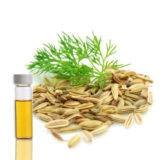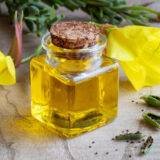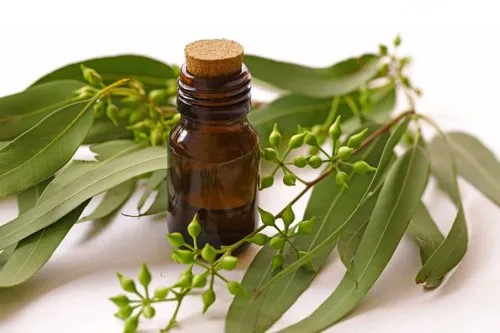Description-
Eucalyptus is an evergreen tree which grows faster, native to Australlia and cultivated worldwide such as in India, Europe & South Africa. Eucalyptus oil is obtained from Eucalyptus globulus belongs to Myrtaceae family. Eucalyptus globulus oil has high content cineole up to 60-70%.
Extraction-
Eucalyptus oil is extracted from fresh or partially dried leaves and young twigs through steam distillation.
Composition-
Its composition are cineole, α-pinene, β-pinene, α-phellandrene, 1, 8-cineole, limonene, terpinen-4-ol, aromadendrene, epiglobulol, piperitone and globulol.
Properties-
Eucalyptus oil is colorless to pale yellow liquid in appearance; its odor is aromatic and camphoraceous, a strong woody and sweet odor taste is followed by a cold sensation.
Blending-
Eucalyptus oil is particularly well blends with benzoin, thyme, lavender, lemongrass oil, lemon, pine, frankincense, rosemary, marjoram and cedar wood oil.
Uses–
- Diluted form of eucalyptus used for respiratory issues as it relieves from pain and inflammation of respiratory tract, mucous membrane, coughs, asthma, bronchitis, sinus pain and other respiratory infections as well.
- It is used for flavoring various products including baked goods, confectionary, meat products and beverages.
- It is used as an insect repellant and biopesticide.
- It is also used in aromatherapy.
- It is used for healing fever and reducing body temperature.
- It also helps in control blood sugar.
- It is used as fragrance as it provides nice, fresh fragrance in perfume and cosmetics with adding antimicrobial properties in soap, laundry and detergent.
- It is used as odor remover, air cleanser and spot remover on carpet, clothes and basically fabric.
- It is used for hair nourishment as it gives hair a nice moisturizing and to ward off dandruff and an itchy scalp.
- It is used as cleaner to remove grease and grime and rejuvenate sore hands and feet.
- It is used for treating cold and flu as it removes toxins and harmful microorganisms which make body feel sick.
- It is used as ingredient in mouthwashes, liniments, ointments, toothpaste, cough drops and lozenges.
- It boosts immune system response.
- It is analgesic in nature, provide relief from pain.
- It stimulating mental activity and also increases blood flow to the brain.
Safety and Precautions-
- Avoid excessive use of eucalyptus oil as it can lead to skin sensitization.
- Do not take orally eucalyptus oil without doctor supervision.
- Do not give children under age 6 and not even in cough drops with eucalyptus oil.
- Pregnant and breast feeding should not take eucalyptus oil.
Specification of Eucalyptus Oil IP:
| Product: | Eucalyptus Oil | |
| Shelf Life: | 2 years | |
| Botanical Name: | Eucalyptus Globulus of Indian Origin. | |
| Testing Protocol: | IP | |
| Organoleptic Properties | ||
| Description | Colorless to pale yellow color, clear liquid, Odor Aromatic & camphoraceous, pungent & camphoraceous taste | |
| Solubility | Soluble in ethanol, chloroform, ether, glacial acetic acid and oils. Practically insoluble in water. | |
| Physio-Chemical Properties:- | ||
| Optical Rotation: | 0°to +10° | |
| Relative Density | 0.897 to 0.924 | |
| Refractive Index | 1.457 to 1.469 | |
| Assay by GC | NLT 60% Cineole Content | |
| Storage Condition | Store in well fitted container, in cool & dark storage area. | |
Eucalyptus Oil:
Botanical Source – Eucalyptus globules
Appearance – Colourless or pale yellow liquid
Odor – Reminiscent of 1, 8-cineol
Identification
- TLC Meets the requirement
- GC Meets the requirement
Specific Gravity – 0.904 – 0.927
Specific Rotation – 0° to +10°
Refractive Index at 20°C 1.458 to 1.470
Solubility – Soluble in 5 volume of ethanol (70%)
Eucalyptol – Min. 60%
Storage – Store in well closed containers, in cool and dry storage Area.
Specification of Eucalyptus Oil:
Testing Protocol – BP
Appearance – Colourless or pale yellow liquid
Odour – Reminiscent of 1, 8 cineol
Identification
- TLC – Meets the requirement
- GC – Meets the requirement
Relative Density – 0.906 – 0.927
Specific Rotation – 0° to +10°
Refractive Index at 20°C – 1.458 to 1.470
Solubility in Alcohol – Soluble in 5 volume of ethanol (70%)
Aldehyde – Meets the requirement
Chromatographic Profile:
α-pinene – 0.05% to 10%
β-pinene – 0.05% to 1.5%
Sabinene – Maximum 0.3%
α-phellandrene – 0.05% to 1.5%
Limonene – 0.05% to 15%
1,8 Cineole – Min. 70%
Camphor – Max. 0.1%
Storage – Store in well closed containers, in cool and dry storage area






